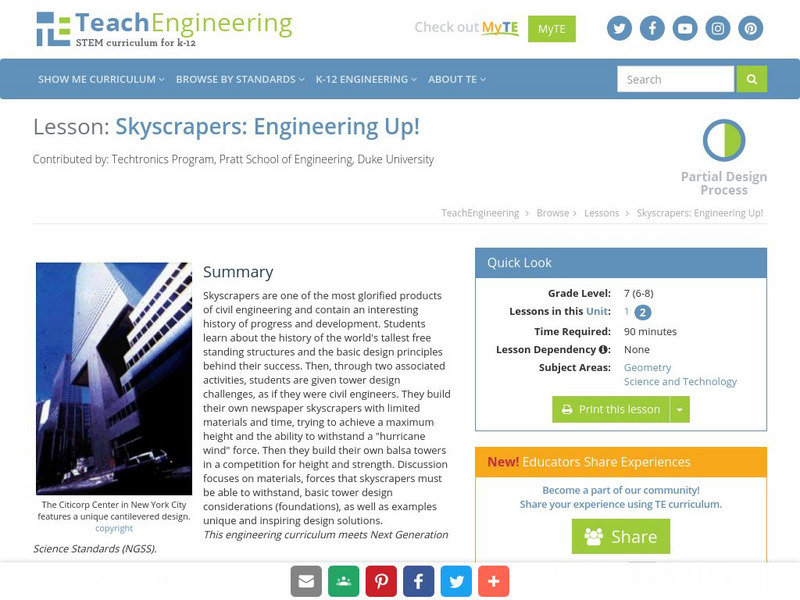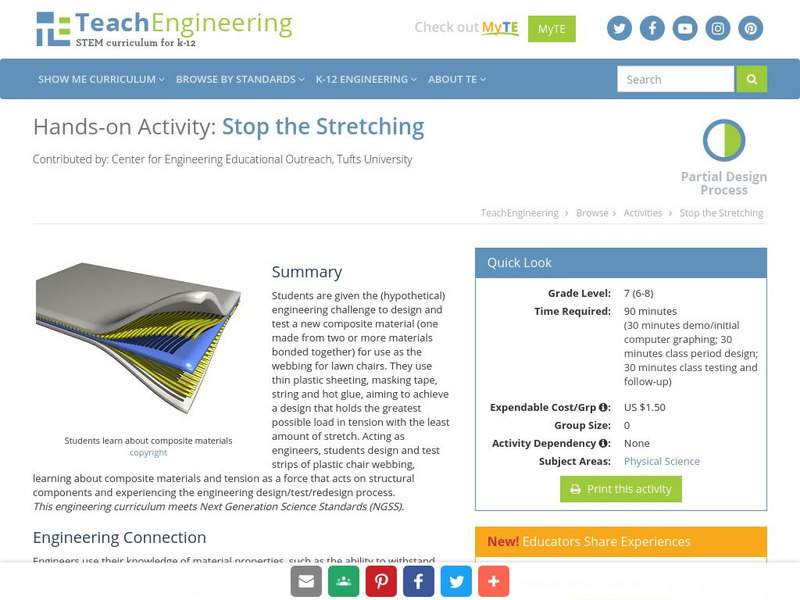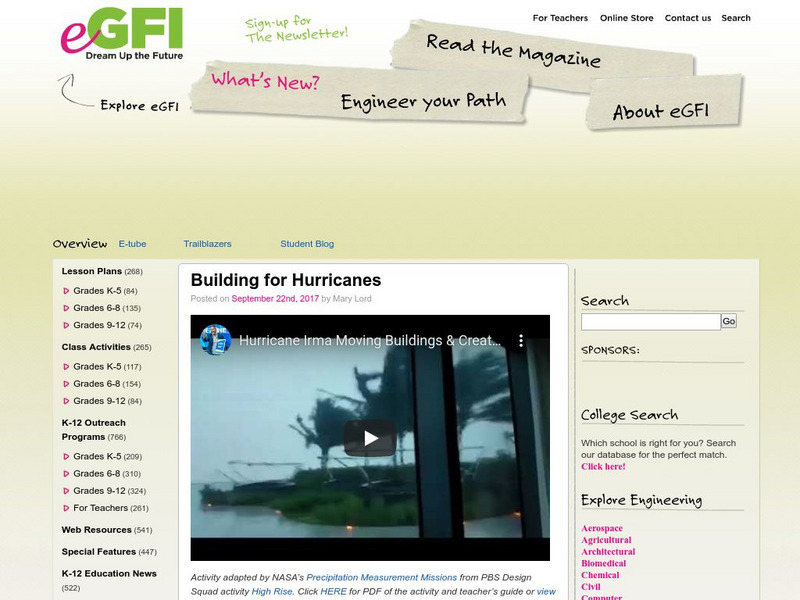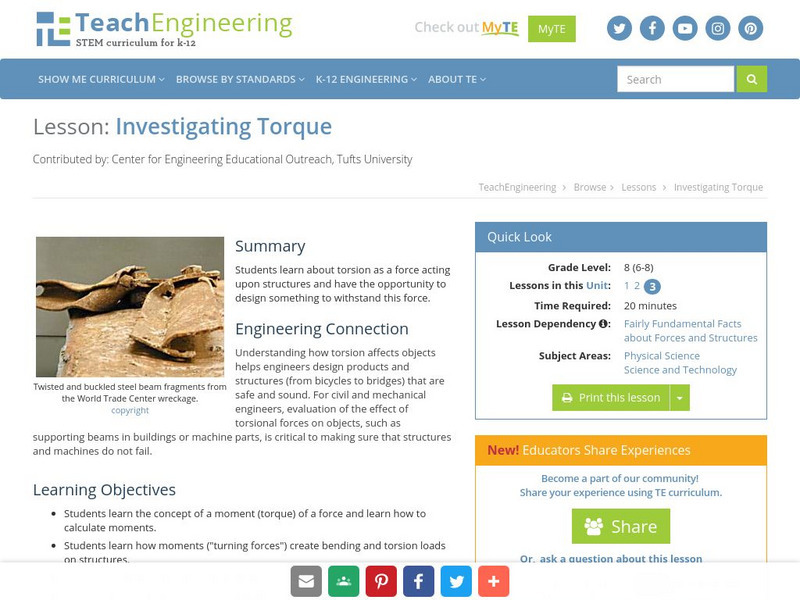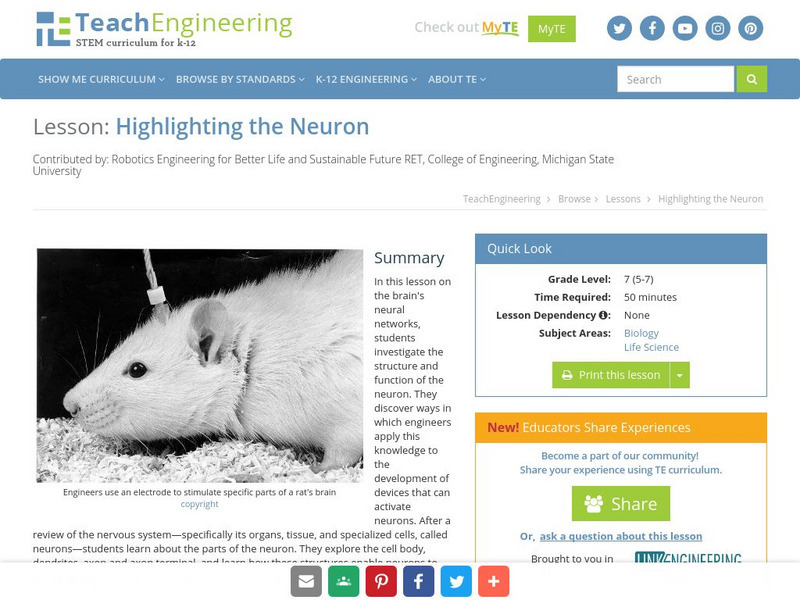TeachEngineering
Teach Engineering: Skyscrapers: Engineering Up!
Skyscrapers are one of the most glorified products of Civil Engineering and contain an interesting history of progress and development. In this lesson plan, the students will learn about the history of the world's tallest free standing...
TeachEngineering
Teach Engineering: Stop the Stretching
Students will learn about composite materials, tension as a force and how they act on structural components through the design and testing of a strip of plastic chair webbing.
TryEngineering
Try Engineering: Engineer a Dam
Students learn about the engineering design process as they design, build, and test a dam structure in a classroom water trough. The objective of the lesson is to learn about the different types of dams and to build one that has the...
TryEngineering
Try Engineering: Engineered Music
Object of this lesson is to learn about the engineering design of musical instruments. Students work in teams to design and build their own "tunable" and unique instrument using everyday materials.
TryEngineering
Try Engineering: Biomimicry in Engineering
This lesson focuses on the concept of Biomimicry and students learn how engineers have incorporated structures and methods from the living world in products and solutions for all industries. Students then work in teams to develop a...
Science Buddies
Science Buddies: Science Careers: Materials Scientist and Engineer
An interest in chemistry and physics is what you need to explore the career of materials scientist or engineer. In this career you manipulate atoms to change the structure of materials to make new products. This Science Buddies site lays...
TryEngineering
Try Engineering: Build a Big Wheel
Young scholars learn about the engineering design process as they design, build, test, and evaluate a big wheel or Ferris wheel made with pasta, glue, and teabags. The objective of the lesson is to explore how big wheels have been...
University of Virginia
University of Virgina: Structural Behavior and Design Approaches
From the Introduction to Structural Design web site. A page of well-written lecture notes on the various structural qualities of building materials. A comparison is made of the strength, stiffness, stability and ductility of materials,...
TryEngineering
Try Engineering: Can You Copperplate?
Chemical engineering lesson plan investigates the processes of chemical plating and electroplating. Teams of students work together to devise a chemical system for plating metal objects with copper, then test and evaluate their findings...
Other
American Society for Engineering Education: Building for Hurricanes
In this engineering design challenge about building in hurricane-prone regions, students learn that a solid base helps stabilize a structure by constructing, testing, and redesigning a tower that can support a tennis ball at least 18...
TeachEngineering
Teach Engineering: Investigating Torque
This lesson focuses on torsion as a force acting upon structures. Students will have the opportunity to design something to withstand this force.
TryEngineering
Try Engineering: Water Tower Challenge
Students learn about the engineering design process as they design, build, and test a water tower made with everyday items. The objective of the lesson is to work in teams to learn about water delivery systems and create one that will...
Learn Engineering
Learn Engineering: Theory of Vibration
Did you know that some bridges have failed due to the effect of vibration? This article and video explore vibration and its importance in the design of civil structures and mechanical equipment. The article discusses all concepts covered...
TeachEngineering
Teach Engineering: Highlighting the Neuron
In this instructional activity on the brain's neural networks, students investigate the structure and function of the neuron. They discover ways in which engineers apply this knowledge to the development of devices that can activate...
TeachEngineering
Teach Engineering: Fairly Fundamental Facts About Forces & Structures
This lesson plan will introduce students to the five fundamental loads: compression, tension, shear, bending, and torsion.
Scientific American
Scientific American: Earthquake Proof Engineering for Skyscrapers
Students construct a shake table, then build towers of different heights using Lego blocks, and test their stability on this platform. Next, they test towers with different sized bases, and towers made using different materials.
TryEngineering
Try Engineering: Solar Structures
During this lesson, students will construct a passive solar house from everyday items then explore how the sun's energy is used to heat and cool it.
PBS
Pbs Learning Media: Smart Bridges
In this video segment adapted from NOVA scienceNOW, learn about engineering innovations that could help detect a bridge's structural weaknesses before they become dangerous. [5:21]
National Institutes of Health
Ncbi: The Molecular Biology of the Cell: The Chemical Components of a Cell
Advanced chapter of the book "The Molecular Biology of the Cell" describes and provides illustrations of our most current understanding of the chemical makeup of cells and their components. Explains in detail how electron activity keeps...
University of St. Andrews (UK)
University of St. Andrews: Charles Augustin De Coulomb
A large complete authoritative biography of Coulomb. Five large pictures, over a dozen links to contemporaries, references, a poster, other mathematicians. A fine source.
PBS
Pbs: American Experience: The Center of the World: Teacher's Guide
Students will have an opportunity to create memorials at the World Trade Center site to commemorate the September 11th attacks. Come and check it out.
Other
Techi Warehouse: Sql Tutorial
This site contains an overview and coding samples for a variety of SQL topics.
Exploratorium
Exploratorium: Science Snacks: Designer Ears
Why do animals' ears all look different? In this activity, you will research all shapes and function of ears to create "better" ears.
State Library of North Carolina
N Cpedia: Fontana Dam
Fontana Dam, the largest dam of the Tennessee Valley Authority (TVA) system, is located on the Little Tennessee River in Graham County. Completed in 1945, it is a gravity-type concrete structure 480 feet high, 2,365 feet long, and 376...
